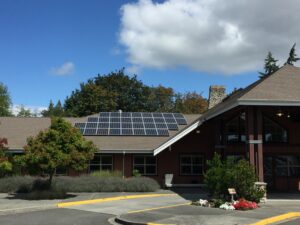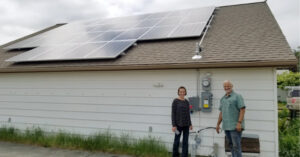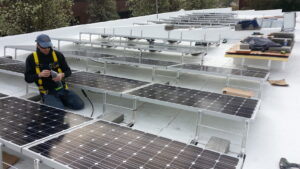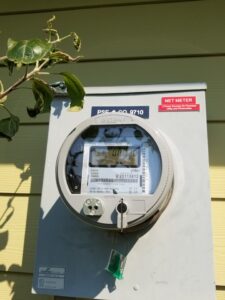Solar Power FAQ
Solar Power FAQ
 Solar energy takes advantage of the sun’s rays to generate heat or electricity. It is an infinitely renewable resource and unique for its ability to generate energy in a quiet, clean, and consistent manner.
Solar energy takes advantage of the sun’s rays to generate heat or electricity. It is an infinitely renewable resource and unique for its ability to generate energy in a quiet, clean, and consistent manner.
Solar panels are flat panels of photovoltaic arrays mounted on a roof or a pole to capture the sun’s rays. Building integrated photovoltaic (BIPV) materials are PV arrays that are integrated into the building material itself, primarily windows, roof tiles, or walls. Solar panels work well for retrofits or remodels while BIPV are appropriate for new construction or a major renovation.
While both types of solar systems capture energy from the sun, solar photovoltaic uses photovoltaic panels to capture light and produce electricity. Solar hot water, or thermal, uses the sun’s energy to heat water for domestic use, to heat a swimming pool, or for a radiant heating system.
Absolutely! Radiant heating applies solar thermal technology. Transferring solar energy through pipes into an in-floor radiant heating system is a wonderful way to stay warm. Radiant floor systems are typically 40 percent more efficient than their forced air counterpart and can be zoned to match thermal comfort to each room.
 The recommended size of your system will depend on your power consumption and what portion of your current electricity needs you would like your PV system to meet. Before investing in solar we recommend that you calculate your total annual energy consumption (available from your utility bill). We then suggest a quick home energy audit (which you can do yourself) to find ways to reduce your energy use by upgrading appliances, windows, insulation, lighting, or by changing your energy use habits. If you reduce your electricity loads, you can generally buy a smaller, less expensive PV system. Purchase your system based on your budget, your present needs, and future expansion potential for more solar electric power and/or batteries.
The recommended size of your system will depend on your power consumption and what portion of your current electricity needs you would like your PV system to meet. Before investing in solar we recommend that you calculate your total annual energy consumption (available from your utility bill). We then suggest a quick home energy audit (which you can do yourself) to find ways to reduce your energy use by upgrading appliances, windows, insulation, lighting, or by changing your energy use habits. If you reduce your electricity loads, you can generally buy a smaller, less expensive PV system. Purchase your system based on your budget, your present needs, and future expansion potential for more solar electric power and/or batteries.
Once you’ve become as efficient as you can (or want to) be, solar is a perfect way to reduce or eliminate how much power you are buying from your utility. A system should be sized to meet no more than your whole load on the sunniest day of the year, and rely on some grid power or battery backup during winter or on cloudy days.
In addition to how much electricity you’d like to generate, the size of your system also depends on these factors: The site’s solar resource or available sunlight; The system’s orientation and tilt; The system’s efficiency at converting sunlight to electricity; Other electricity sources, like a utility, a wind turbine, or a fossil fuel generator.
The most accurate way to size your solar electric system is to have Fire Mountain Solar come to your home or business and perform a site analysis and load assessment. We have the experience and tools necessary to gather the data needed for the calculations, and will design a PV solar system package to meet your needs. Accurately sizing the components of your solar electric system helps ensure that your system will produce the amount of power you want it to produce at a reasonable rate of return on your investment.
Solar electric systems for Western Washington homes are generally sized in the 6 kW to 12 kW (6,000 watt to 12,000 watt) range. The cost of your system will vary depending on which products are best suited for your application and what incentives are available in your specific area, but as a ballpark you can expect to spend between $2.50 and $2.75 per watt of solar installed (at 2018 prices).
According to the National Appraisal Institute, for every $1 of electricity that you offset with a renewable energy system your home value will increase by $20. Also, a home with a renewable energy system is generally more attractive to buyers, even when compared to an otherwise identical home right next door; big pluses in today’s tight housing market.
The general rule is that 100 square feet of roof space is needed for every 1,000 watts of solar panels.
Though a South facing roof is always best, SE to SW also work well. In our region, SE to SW orientations result in annual energy production at about 96% to 98% of a South facing array. Even due West or East orientations are workable, but the amount of power generated is reduced to about 82% to 88% of what you would get with a Southern orientation. Adding a few more panels to your array will often compensate for these losses.
 Different roofing materials and pitches require different mounting systems, but pretty much any roof can be installed with solar. The type and pitch of your roof will affect the overall installation cost of your system, so it is important to enlist the help of an experienced solar professional to determine the best method for mounting your array. This will ensure the panels are at the best angle to take advantage of year-around variations in light, and that the installation does not compromise the integrity of your roof. Standing seam metal and composition roofs make installation the easiest; flat and wood shake roofs make installation more difficult. If your roof will need to be replaced during the next ten years we recommend you either wait to install solar or that you replace your roof now.
Different roofing materials and pitches require different mounting systems, but pretty much any roof can be installed with solar. The type and pitch of your roof will affect the overall installation cost of your system, so it is important to enlist the help of an experienced solar professional to determine the best method for mounting your array. This will ensure the panels are at the best angle to take advantage of year-around variations in light, and that the installation does not compromise the integrity of your roof. Standing seam metal and composition roofs make installation the easiest; flat and wood shake roofs make installation more difficult. If your roof will need to be replaced during the next ten years we recommend you either wait to install solar or that you replace your roof now.
The general rule is to have no shading from 10:00 am to 3:00 pm. Tall trees to the SE or SW can be a problem, particularly in the winter when the sun is lower on the horizon. However, in Western Washington where the winter days are short and tend to be cloudy, it is possible to compensate for many winter shading issues. Fire Mountain Solar can perform a complete site analysis that will identify the shading effect of any surrounding trees or structures year-around, and make suggestions for optimizing your solar exposure.
Yes. Every year more financing options become available for installing renewable energy at your home or business. Many local lending institutions are now offering loans specifically for solar. For example, many of our customers have taken advantage of low rates at Puget Sound Cooperative Credit Union (PSCCU). Please click here for more information on solar financing and other solar incentives. You may also want to consider using a home equity loan for the purchase and installation costs of a solar photovoltaic or solar hot water system to take full advantage of federal tax deductions. Many utilities offer rebates or low-interest loans for solar electric and solar hot water systems.
Most homeowners insurance policies include coverage of solar panels, which means no separate insurance is needed. Components of a solar energy system including the rooftop panels or tiles are usually considered a permanent attachment to your property, similar to a patio or a security system. You will want to let your insurance agent know when you add solar in case your coverage needs to be increased to cover it. And be sure to read the fine print of your coverage, as some policies may exclude damage when it’s caused by a particular threat, such as wind.
Probably. Many areas still do not require a building permit for solar photovoltaic or solar hot water systems, but as far as we know all areas do require an electrical or plumbing permit based on the type of system.
No. Fire Mountain Solar has worked with hundreds of people across the US who wanted to install their own solar electric system (solar hot water is a bit more challenging, but not impossible to do yourself). We do recommend that you get professional help from a qualified, experienced solar professional to design the system and help you select the best components for your application. We can design the system for you, provide you will all the components you need, and provide expert technical guidance via telephone and email throughout your installation and after it’s complete.
That said, using a solar professional can take the guesswork out of installing a solar power system and provide you with peace of mind. Whether you are considering solar photovoltaic, solar hot water, or a radiant floor heating system, an experienced solar professional can help you with all the details.
As with any major purchase, it’s helpful to compare costs and information. Seeking information from multiple professionals can provide constructive advice, set realistic expectations, and help you fine-tune the design that will work best for your application.
In this growing industry new companies are popping up on a regular basis and it’s not easy to know which installers are adequately qualified to do the job. Choosing the right solar professional often means the difference between a satisfying experience and a nightmare. Often the low bid is from a company that is highly qualified and has a well-managed operation, but sometimes it comes from a company that will cut corners or that may not fully understand the job requirements. As you would when hiring any type of professional contractor to work on your home, be sure to ask about their experience and for references. Also, consider checking for third-party verified surveys online.
You can estimate how much a solar electric or solar hot water system may cost if you determine your current energy needs and costs and compare against your future anticipated use. Once you have a sense of how much energy you use, you can evaluate the cost of purchasing and installing one or both of the technologies.
Luckily in today’s market you can take advantage of multiple federal, state, and local tax credits, rebates and other financial incentives that create attractive and competitive prices for solar PV and hot water systems. Click the following link to be taken to the Database for State Incentives for Renewable Energy (DSIRE) www.dsireusa.org or contact Fire Mountain Solar and we’ll help you determine what incentives you are eligible for.
Planning, configuring, and product ordering can take up to a few weeks. However, the installation process itself typically takes only a few days.
You will need a photovoltaic array (solar panels) to capture the sun’s energy, an inverter to convert the direct current (DC) produced from the photovoltaic cells into alternating current (AC) used by your home, and a house utility meter – called a net meter – that can record both the electricity produced from your home’s power system as well as any power you may use off the grid. These three system components are then connected through a series of wiring. The photovoltaic panels are secured to your roof with panel mounts or are installed on poles that can be adjusted for sun angle. In areas where there is a production incentive, you will also need a production meter, which is provided by your utility at little or no cost to you.
 Net meters look very much like other outdoor meters with one notable exception – they spin both forward and backward, recording both the power produced and power used.
Net meters look very much like other outdoor meters with one notable exception – they spin both forward and backward, recording both the power produced and power used.
Probably not – a backup battery bank can add as much as 25% in cost to a residential solar PV system. It’s not necessarily more efficient either – a same sized solar array will yield about 7–10% less energy if it’s battery-tied than its grid-tied counterpart.
Though you will remain tethered to your local utilities’ grid, you will not have to worry about not generating enough power. You also gain the advantage of offsetting rising utility costs. Most solar photovoltaic experts do not recommend adding a backup battery system unless there is concern about a long utility outage or the residence is in a remote location.
Solar panels typically have 20 to 25 year performance warranties and 1 to 5 year workmanship warranties. Testing shows that panel lifetimes generally exceed 25 years. As a matter of fact, the very first solar panel created by Bell Labs in 1945 is still producing power today!
Since there are no moving parts, the system is basically maintenance free.
